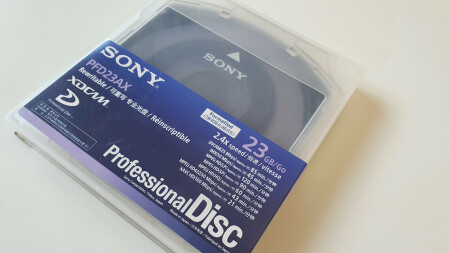Digitisation project 10: XDCAM
The XDCAM transfer project, in which we’re converting professional XDCAM discs, is running at full speed. Initial preparations took place in 2018, with the project officially starting in 2021. With a collection of more than 6000 XDCAMs, it’s quite an unusual task. As a transfer project, it lies somewhere between digitisation and digital intake, so we’re adopting a different approach compared to our previous digitisation projects.
Challenge
XDCAMs are used to store digital video recordings. These carriers are also known as Professional Discs, but the XDCAM brand name from Sony is more popular. In contrast to many other video carriers, they use an optical disc in a plastic casing rather than magnetic tape. This means the XDCAMs are not like the digital files that flow in via a digital intake process, but they’re also not conventional carriers such as those used in other digitisation projects. XDCAMs can be compared with computer diskettes; you can save any files on them but you need a special device to read the data. That’s why this project therefore lies somewhere between a digitisation and digital intake process.
Because this project is not dealing with a digital intake or digitisation, we refer to it as a digital transfer project. This means we need to reconceive the approach used in previous digitisation projects.
Approach
We’re processing more than 6000 XDCAMs, mainly from regional broadcasters BRUZZ and RINGtv, in this project. Each disc has ten files on average, resulting in around 60,000 altogether. The content is primarily news reports, full news broadcasts and general programmes from the period 2000 until now. We’re aiming to complete the project by the end of 2022.
In contrast to previous digitisation projects, we’re not working with an external digitisation company this time. The XDCAMs will be read on site at the BRUZZ and RINGtv premises because they have the right playback equipment. They will therefore read the files themselves before sending them on to meemoo. Once received, we will add them to the meemoo archive system where they will be stored sustainably and kept ready to be used again. This means, unlike other digitisation projects, we can skip the registration, packaging, sending and other stages.
The two regional broadcasters started converting their own collections in 2021. BRUZZ now has 3,500 XDCAMs and RINGtv has 2,696. Alongside these collections, we’re also including 141 disks from three other content partners: DIVA - Museum for Diamonds, Jewellery and Silver (1), Turnhout City Archive (6) and the Provincial Archives of West Flanders (134). BRUZZ will transfer their disks in the final stage of the project.
- T • +32 9 298 05 01
- M • laura.ulens@meemoo.be

